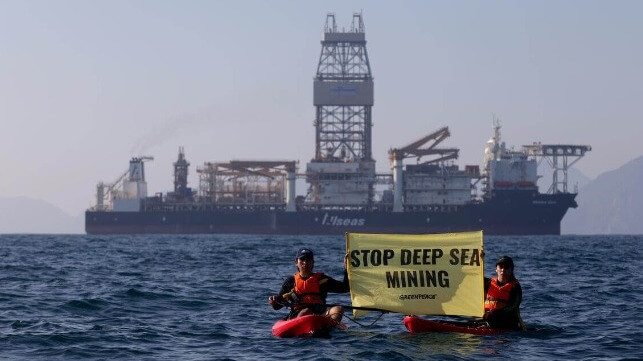Protestors Demonstrate as Deep-Sea Mining Vessel Completes Trial

Greenpeace activists from Mexico and New Zealand renewed their protests over deep-sea mining again targeting the drill ship Hidden Gem, as it returned from its first test mission in the Pacific. The vessel has been the target of past previous environmentalists’ protests over the controversial practice of extracting precious minerals from the deep sea.
The Hidden Gem (61,000 dwt) is a converted drill ship, operated by Swiss company Allseas and commissioned by Canadian miner The Metals Company. While the vessel was undergoing its conversion in Rotterdam in preparation for the new role it was targeted, and again at the end of last week as it arrived off the coast of Manzanillo, México after eight weeks of test mining.
Activists from Greenpeace protested in kayaks holding banners that read “Stop Deep Sea Mining,” as the vessel reached Mexico. Greenpeace Aotearoa campaigner James Hita, onboard a small vessel off the Manzanillo coast, also delivered a message of protest to the captain of the Hidden Gem via radio. The protest was mostly symbolic to draw attention to their cause.
Hita repeated Greenpeace’s position that deep-sea mining will not be tolerated. He read a statement over the radio saying, “We are here today because deep sea mining threatens the health of the ocean and the lives and livelihoods of all who depend on it. The ocean is home to over 50 percent of life on Earth and one of our biggest allies in fighting the climate crisis. We will not stand by while mining companies begin to plunder the seafloor for profit.”
The Hidden Gem deployed in early October to the Clarion Clipperton Zone between México and Hawaii. The vessel carries a crawler designed to collect manganese nodules, small grape- to potato-sized accumulations that grow on the ocean floor which can contain about 1.5 percent nickel, 1.0 percent copper, 30 percent manganese, and about 0.25 percent cobalt, along with traces of rare earth metals, according to the International Seabed Authority. The vessel has a robotic nodule collection system along with a lift system using compressed air to bring the material to the surface. The vessel was expected to lift 3,000 tons of polymetallic nodules from the seafloor in the trial that just concluded.
The Metals Company previously called the tests a historic moment in the development of this industry. The company noted that the trials would be monitored by independent scientists from a dozen leading research institutions around the world who will analyze the environmental impacts of both the pilot nodule collector vehicle and the nodule riser system. They plan to analyze the results of trial and previous offshore campaigns to provide the basis of an application to the International Seabed Authority for an exploitation contract. Greenpeace expects that application will be filed in 2023.
Greenpeace highlights that the governments of Palau, Samoa, Fiji, Micronesia, Chile, and New Zealand have all declared that they would back a deep-sea mining moratorium. Germany has said it would back a precautionary pause, while last week at the UN COP27 conference in Egypt, French President Emmanuel Macron recently called for a ban on the process.
Last December, Greenpeace also targeted the vessel climbing aboard to hang banners against deep-sea mining. Two months later, protestors from Ocean Rebellion also targeted the vessel for their protests tied to the One Ocean Summit which was being held in France. The Hidden Gem, which is registered in Malta, is currently anchored in Manzanillo having completed its test mining program.
